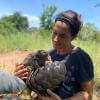WILDLABS Washington DC Meet-Up
21 February 2024 7:33pm
WILDLABS NYC Networking Event
21 February 2024 7:27pm
SMART Partnership Director
21 February 2024 4:32pm
Senior Software Engineer, Skylight
21 February 2024 3:44pm
Technical Field Officer
21 February 2024 3:40pm
Scaling biodiversity scoring for supply chains aligned with TNFD
20 February 2024 9:44am
Li-ion rechargeable batteries suddenly drain
2 February 2024 6:13pm
15 February 2024 9:26am
Hi Frank,
Yes, I agree. There is a halfway-house solution if you take a look at the Energizer Ultimate Lithium range of batteries. They have superior life to alkaline batteries (3.5Ah in a single AA cell), though they are of course still one-time use. They would also work a little better with your battery monitor since they have a graceful degradation between 1.8V down to 1.5V, but then they fall off a cliff ;-)
16 February 2024 1:00pm
A multi meter would probably not be enough, unless you have a very fancy one. To get the energy use, you need to be able to integrate the current drawn over time. Something like this: Otii Arc Pro
I don't know how much you paid for these, but Amazon Basics has a line of rechargeable AA batteries, including a high capacity version which can store 2400 mAh which is a little more than the ones you're using. (I've seen even more capacity with other manufacturers.)
You might also want to consider avoiding batteries with USB ports in the future. It seems to me like just an additional thing that can break, especially if moisture could be an issue.
18 February 2024 8:20pm
Thanks for the link, Amanda. The price of $900 is a bit too steep for me, but at least I now know a bit better what you meant with a power analyser.
I can't remember either what I paid for the batteries, but I try to avoid buying stuff from mr. Bezos, because he is rich enough as far as I am concerned.
The moisture issue slipped my mind when I was in Europe. As far as I remember, I liked the usb ports because I bought the batteries as a test and I didn't want to buy a separate charger, as I thought one needed one designed for Li-ion batteries. The usb ports made that possible.
WiCT active?
16 January 2024 9:14am
26 January 2024 2:17pm
Hi Paola! It's Meredith (former Pringle lab in Gorongosa) - great to see you here! Would love to touch base about the WiCT network and programming - we ran a similar programme to this in Gorongosa two years ago and are gearing up for another women's session in Gorongosa this August. It would be great to involve you if you're interested?
16 February 2024 1:30pm
Hi Meredith! let's definitely chat. my tel is +258-84-304-8602
18 February 2024 4:22pm
Super, I'll be in touch soon!
Tools for automating image augmentation
26 January 2024 2:33pm
16 February 2024 7:42am
Hi @arky !
Thanks for your reply.
I am running into pytorch/torchvision incompatibility issues when trying to run your script.
Which versions are you using?
Best regards,
Lars
18 February 2024 11:05am
@Lars_Holst_Hansen Here is the information you requested. Also run Yolov8 in multiple remote environments without any issues. Perhaps you'll need to use a virtual environment (venv et al) or conda to remedy incompatibility issues.
$ yolo checks
Ultralytics YOLOv8.1.4 🚀 Python-3.10.12 torch-1.13.1+cu117 CUDA:0 (Quadro T2000, 3904MiB)
Setup complete ✅ (16 CPUs, 62.5 GB RAM, 465.0/467.9 GB disk)
OS Linux-6.5.0-17-generic-x86_64-with-glibc2.35
Environment Linux
Python 3.10.12
Install pip
RAM 62.54 GB
CPU Intel Core(TM) i7-10875H 2.30GHz
CUDA 11.7
matplotlib ✅ 3.5.1>=3.3.0
numpy ✅ 1.26.3>=1.22.2
opencv-python ✅ 4.7.0.72>=4.6.0
pillow ✅ 10.2.0>=7.1.2
pyyaml ✅ 6.0.1>=5.3.1
requests ✅ 2.31.0>=2.23.0
scipy ✅ 1.11.4>=1.4.1
torch ✅ 1.13.1>=1.8.0
torchvision ✅ 0.14.1>=0.9.0
tqdm ✅ 4.66.1>=4.64.0
psutil ✅ 5.9.8
py-cpuinfo ✅ 9.0.0
thop ✅ 0.1.1-2209072238>=0.1.1
pandas ✅ 1.5.3>=1.1.4
seaborn ✅ 0.12.2>=0.11.0
18 February 2024 11:18am
Perfect thanks! I am still a novice using Python but my wife can help me!
Seeking Advice on Thermal Drones for Night-Time Elephant Observation
25 December 2023 9:53am
13 February 2024 8:39am
Hi Nilaksha (and everyone else),
I have been looking at the application of thermal to improve the automated detection through RGB imagery. One of the large drawbacks of thermal is the lower resolution. This is impart cost but also down to basic physics, IR light has a much longer wavelength and therefore a sensor can't have as many 'pixels' on it compared to an RGB sensor. This implies that you either need a thermal camera lens with a longer focal length, which reduces the area you cover, or you need to fly much lower. The drawback of the latter is you cover much less ground per unit of time/battery and you have the potential of disturbing the animals.
I know that DJI have recently released a starlight camera combined with thermal (DJI Enterprise Zenmuse H20N). It looks very impressive but I have not yet managed to test it. Being self-funded as well I have opted for hiring in a drone company to fly for me with the state of the art equipment rather than buying and flying myself.
Hope that helps and keen to hear how you get on!
16 February 2024 8:23am
@PaulS Thank you. It sounds great. I'll have a look and get back.
16 February 2024 8:34am
@PaulAllin Thanks for your valuable insights. Zenmuse H20N seems to be very powerful and useful in this case. However, I'm looking for a more affordable option for a self-funded research.
Data Scientist at United Nations Environment Programme (UNEP)
15 February 2024 5:22pm
Mothbox + Mothbeam Update: 4
31 January 2024 7:09pm
15 February 2024 4:49pm
We did some more testing with the Mothbeam in the forest. It's the height of dry season right now, so not many moths came out, but the mothbeam shined super bright and attracted a whole bunch of really tiny things that swarmed a lot


and some nocturnal bees

you could also see the mothbeam's aura from far away in the forest! so that was impressive!

I also tested out attaching a 12V USB booster cable to the Mothbeam, and it works
nice! So you can attach regular USB 5V battery packs to the mothbeam as well!
3x Ai 4 Conservation Job Roles (UK)
15 February 2024 3:28pm
Workshop: Advances in eDNA for monitoring and ecological studies of marine mammals
14 February 2024 7:25pm
Contrasting strengths of eDNA and electrofishing compared to historic records for assessing fish community diversity and composition
14 February 2024 7:24pm
This study investigated the accuracy of eDNA and electrofishing as alternative methods for assessing diversity.
Exploring an ethical reflection tool for animal-focused tech (Survey)
13 February 2024 8:22pm
New DNA tests achieve first convictions for raptor thefts
13 February 2024 7:12pm
Gender Representation in the WILDLABS Awards 2024 Submissions
 Alex Rood
Alex Rood
13 February 2024 5:37pm
14 February 2024 1:37pm
21 March 2024 9:59am
1 April 2024 4:30pm
Data Logger Suggestions
31 January 2024 1:42pm
10 February 2024 2:19am
Hi Andrea,
The OpenLog Artemis might be an option. I haven't used one of these yet, but its what I immediately thought of. Built in real time clock and IMU that records to microSD. It has four 14-bit ADCs and I2C connectors for the 'Qwiic' or 'grove' sensor boards. I'm not sure if it has programmable on/off cycles with the clock but you may find an existing project that does this.
13 February 2024 4:29pm
Thank you for the help!
Funded PhD Opportunity: Moose Acoustics at the University of New Hampshire
13 February 2024 1:21pm
Computer Vision for Ecology Workshop 2025 Call for Applications
12 February 2024 9:29pm
Early career mammalogist funding Opportunity
12 February 2024 8:57pm
Seeking doctoral student to Join Move.inFormation research group for Andean condor biologging
12 February 2024 8:01pm
eDNA Collaborative: Small Grants Application for Marine eDNA Research
12 February 2024 7:45pm
The eDNA Collaborative is partnering with Experiment to offer $80,000 in small grants to support projects that demonstrate novel approaches in marine eDNA collection, analysis, or application.
Submission Deadline: March 30, 2024
Wildlife Drones will be hosting in-person demos in the U.S.
12 February 2024 3:32am
Seeking advice for remotely retrieving high frequency acceleration data
28 January 2024 1:26am
28 January 2024 9:42am
Hi Maggie!
This sounds like a really interesting - and challenging project!
UHF is used for tranfer of acceleration data (along with other stuff like magnetometry and GNSS locations) by systems developed by companies like Milsar and TechnoSmart.
Ceres Wild uses satellite transfer over the GlobalStar but no raw acceleration data is transmitted.
I would fear the bandwidth would be too restrictive if you insist in using satellite based transfer of accelerometry.
Cheers,
Lars
29 January 2024 5:19pm
This sounds like a lot of fun!
The lowest cost satellite comm I know of is https://swarm.space/. It's pretty cool tech, but the data rates are quite low.
Do you have any idea how much data you need to move per day on average?
Perhaps LoRa would be an option? Here is an example of a LoRa device https://www.adafruit.com/product/4284
LoRa is not satellite, but it has quite a long range which may suffice? It is also pretty low data rate, but it is a good deal better than Swarm. The best thing about LoRa is that the end-point can be very low power, so battery life can be quite good.
If you know somewhere the crocs frequent, you might also be able to work something out with Bluetooth LE? Both LoRa and Bluetooth would require the installation of at least one base station. Lora's base station could be substantially further way.
11 February 2024 2:33am
I have a few suggestions Maggie. Hopefully one or more will be useful.
Preprocessing - Compressing the data before transmission will reduce file size and reduce transmission time.
Reduce data volume - I guess the animals are only active for some periods and a lot of the time are just "cruising along". So a useful strategy could be to only start recording when a certain threshold of acceleration occurs. And if you also buffer the data for say 10 seconds, you will get info about what's leading up to the activity. And adding a GPS module you will get some info on where the activity occurred plus movements prior. This will of course increase the data volume but only recording the most recent location will probably suffice as the location of the previous activity will tell you how far the animal moved.
Use LoRa instead of satellite - LoRa is well suited to this type of application. I saw in
that the home range of crocodiles is relatively small so although a forested area will limit LoRa performance, the range should be sufficient. You could also use multiple base stations if needed.
Of course eventually the data that has been recorded at the LoRa base station(s) will need to be collected. You could add a long range radio to the base station, or just collect the data 'manually'.
Hope this helps
PhD position: Foraging in the landscape of peril
10 February 2024 7:27am
Post-doc possition - Field spanning movement ecology, ecology of fear, bio-logging science, behavioral ecology, and ecological statistics
10 February 2024 7:20am
Funding for Camera Trap Projects
24 January 2024 5:23pm
9 February 2024 6:42pm
I'm in Paraguay!
I'm looking for any starting points - databases, specific orgs i can apply to etc.
I have found a nonprofit I've been working with and have found several grants to apply through my partnership with them but am obviously looking for more.
9 February 2024 6:42pm
I'm in Paraguay!
I'm looking for any starting points - databases, specific orgs i can apply to etc.
I have found a nonprofit I've been working with and have found several grants to apply through my partnership with them but am obviously looking for more.
9 February 2024 6:45pm
This is a great starting point - thanks for the help
eDNA Innovation Grants
9 February 2024 4:26pm
























22 February 2024 1:40pm